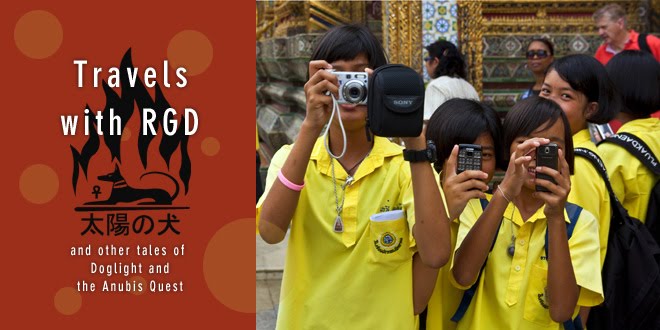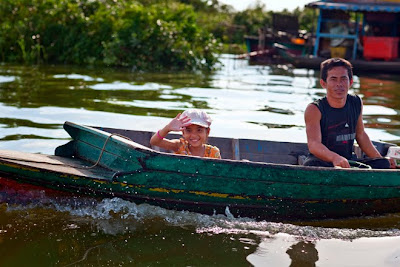I slept in a little late this morning, finally getting up at 7:30 to start to get ready. At 8:30 I met Ann over in the dining room and we devoured our pancakes and honey with gusto. Mr. Poy Pines arrived just as we were finishing, and after collecting our cameras and my hat, we were off for a morning in Siem Reap and then an afternoon on Lake Tonie Sap.
First stop: The Angkor National Museum. It's a giant place. Built within the past couple of years, it's still gleaming, and in a tropical climate like this, that's saying something.
We purchased our tickets for twelve bucks and climbed the circular staircase up to the tour's starting point: the Multi-Media theatre. Watching a presentation on Khmer art and history is mandatory before visiting the other eight galleries of the museum. After the show, you go into what I believe is the high point of the museum (even if it's a bit gimmicky) -- "The Room of a Thousand Buddhas." The totality of the room is fascinating. I could have spent all day there, if only there had been a place to sit down and contemplate. From that room, you are guided through a series of seven other galleries that display masterful examples of Khmer art through the different periods of Cambodian history. My only gripe is that the presentation is overly dramatic. I found the theatrical lighting distracting, and in my opinion it lessened the impact of the artist's vision. One of the frustrating things about this museum is that you aren't allowed to take photographs in any of the galleries. And to top that off, they don't have a comprehensive catalogue of the museum's collection. So the only thing you can take away are your memories. It would have been wonderful to walk away with some of the diverse images of the Buddha to study later on. The other minor drawback is the flow of the place, which reminds me of the Guggenheim in New York; gravity is always pulling you towards the egress.
After finishing the tour and exiting the museum, we found Poy and a couple of other guides and drivers eating breakfast in the parking lot. They'd just started, so we excused ourselves and headed over to the museum's mall to kill some time. Climbing the stairs, we walked into near-glacial conditions and the sweat on my back immediately turned to ice. I hate places like this, it's how you get sick. It’s like walking from the steaming jungle into the Arctic Circle. This is a large mall with a powerful air conditioning system. Just a few of the ground-floor shops were open, a cultural bookstore, a Baskin-Robbins ice cream parlor, and a museum store with expensive reproductions. I hope they get more visitors later in the day, because right now the employees outnumber us 10 to 1. I took the cold for as long as I could stand it, then headed back to the parking lot. The drivers were just finishing their meal and I jumped into the van to defrost. Ann was smoking one last cigarette before we moved on.
Next stop was the park in front of the Ruffles Grand Hotel d'Angkor. This had been the first luxury hotel in the town and to say thanks, the Ruffles organization had presented the park to the people of Siem Reap. It's a wonderful place; in the evening it is filled with promenading couples and joyful young people. We parked in an area reserved for tourist vans and walked out to the road that fronts the park. It has a median strip that is home to a popular shrine. There is a golden sunshade that gives shelter to a Buddha that the devoted have covered in makeup and fingernail polish. It's supposed to be the Buddha that is favored by the town's sex workers, and it looks like they really love this Buddha. Across the street is a full-size temple surrounded by a grove of trees that are home to a colony of giant bats. At first I thought they were just large birds, until Poy pointed out that they didn't have feathers. Ann went into the temple to grab some shots and I stayed outside, watching the bats.
Close to noon we drove to Pub/Bar Street and got dropped off. Ann, Poy, and I were going to spend the next couple of hours trying to get a few more photos of the town and shop-people. After we'd walked for 20 minutes, we walked past a foot massage place and Ann decided that it was what we needed to do just then. We took off our shoes in the foyer, went into the massage room and sat down in chaise lounges, pulled our pant-legs up over our calves, and watched as the masseuses took pointy sticks and jabbed them into the pressure points of our feet. It was too hard for Ann and not hard enough for me. The massages were to take 60 minutes, so we told Poy to take a break while we had our feet pummeled.
When the massages were over, we paid the shop and tipped the girls, put our shoes back on, and walked out onto the street. Our feet were a little unsteady on the pavement; we needed to find a place to sit down. We stopped at an outdoor cafe and ordered drinks. When the drinks came, I noticed that there was a shoeshine stand across the street. Telling Ann and Poy I’d be right back, I walked over and dropped off my Timberlands for a quick polish. The cobbler let me borrow a pair of thongs to wear while he worked on my boots. Ten minutes later he gave me a wave, my boots were a shiny black again, and he was two dollars richer.
Lunch was at the Soup Dragon again. Just waved at the waitress, who knew what we wanted. She brought over the drinks and said that the spaghetti would be ready soon.
After finishing our meal, we continued to shoot until about 1:30, and then we went back to our rooms to refresh ourselves for an hour. I didn't want to get to the lake too early. Last year we'd gone around noon and the light was way too high to get any good shots.
On the way back we made one fast stop at the Bangkok Airways office as I needed to reconfirm our reservations for tomorrow's air travel.
Travel Tip: It's important to always reconfirm your reservations a day or two before you're scheduled to fly. Otherwise you could find that they've overbooked the flight and you don't have a seat.
Arriving at the lake's staging area at just before 3 p.m., we found there were a couple of large groups waiting to board. We gave Poy some cash and he snaked his way through the crowds and bought our tickets ($20 each, for an hour and a half on the water). As I understand it, there are always small boats available, it's only the large ones you have to wait on. Poy led us down the dock to a rickety-looking boat captained by a young man in his early 20s. I jumped in, followed by Ann, who pointed out that there weren't any life jackets. I just smiled and shrugged my shoulders.
On my last visit I'd learned that most of the fishermen who lived on the lake were Vietnam refugees or their descendants. They were in Cambodia illegally, so they couldn't own property. As an alternative they had constructed a life by building floating communities on the lake. Most Cambodians aren't real happy about the situation, but to make up for the inconvenience they've turned the floating cities into a tourist attraction and give tours throughout the day. Most of the floating communities are located in a large inlet of the lake. The tour boats make a run out to the lake proper and then turn around and head back, making a stop at a floating refreshment stand halfway back. These stands are like the old trading posts along old Route 66 in America; lots of trinkets and animal carcasses. They also have large floating water cages filled with fish and alligators. There really isn't a reason to stop here, other than it's one of the mandatory stops for the driver and it's a major profit center for the locals and the government.
The young descendants here are creative. Not wanting to fish for a living, they've adapted to the tour boat's intrusions into their lives. Being enterprising, they've built small boats with very large, souped-up engines and man them with two-person crews composed of a young man to control the boat and a cute young girl to do the selling. The boats zoom in and around the tour boats. When they are close enough, the girl leaps from her boat to the tour boat and immediately begins her spiel, in hopes of selling a couple of cold drinks. Once the transaction is completed she jumps back onto her boat and they speed on to the next opportunity.
Our boat got really close to the floating homes. We could see right into the peoples lives and homes. They seemed really good-natured about our intrusion, but I'd guess that they tend to get pissed off at someone trying to photograph them trying to relax in their living room. We got some really intimate shots of the people of the floating villages.
When the boat got back to the docks we tipped the boat captain and made our way to the van. The light was really nice now, so we had the driver leave and park about a mile up the road so we could walk and take pictures of the homes that surrounded the launch area. This area is the anchor area for the floating villages, and our walk gave us remarkable insight into the way these people live and thrive in very hard conditions. It took an hour to reach the van, and I had to change out the memory card, I’d been shooting out my brains out.
We stopped downtown for the last time to have dinner. The van dropped us off and we walked around getting a few things that we wanted. Ann needed some smokes so we stopped at a street vendor where she bought some Marlboros. The lady who was selling the smokes had a lovely daughter who was 4 or 5 years old and very precocious. She took a lovely picture. We had dinner at the Soup Dragon and watched the people moving up and down Pub Street (for us Americans, the locals call it Bar Street).
Back at La Villa Mona I settled accounts with the guest house and with Mr. Pines. I also tipped the van driver, who was a reliable fellow.
Back at the bungalows, I went over the costs with Ann and cleared the books between us. That done, I went back to my room and turned on the air conditioning (low setting), laid out what I was going to wear tomorrow, turned on TV, and tried to relax.
Later as I was drifting off, I found myself regretting that we were leaving so soon. Even with all the inherent problems, there is something about Cambodia that is magically intoxicating.


























